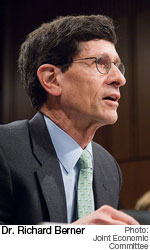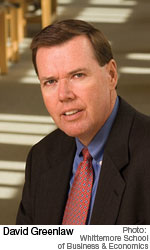Delivering accurate and consistent economic forecasts for the years of 2008, 2009, 2010, and 2011 – one of the most volatile periods in the history of the U.S. economy – could be called a near miraculous feat, and yet that is what two economists accomplished. Unfortunately, they are not predicting any miracles for the economy in 2013.
 The economists, Dr. Richard Berner, counselor to the Secretary of the U.S. Treasury, and David Greenlaw, Morgan Stanley’s chief U.S. fixed income economist, were awarded the 2012 Lawrence R. Klein Award for Blue Chip Forecast Accuracy by the W.P. Carey School of Business at Arizona State University.
The economists, Dr. Richard Berner, counselor to the Secretary of the U.S. Treasury, and David Greenlaw, Morgan Stanley’s chief U.S. fixed income economist, were awarded the 2012 Lawrence R. Klein Award for Blue Chip Forecast Accuracy by the W.P. Carey School of Business at Arizona State University. Berner and Greenlaw were colleagues at Morgan Stanley during the period for which they were honored. They bested 50 other economists who submitted forecasts in four key indicators – gross domestic product (GDP), consumer price index (CPI), unemployment, and the Treasury bill rate – each January in the Blue Chip newsletter. They had the most accurate economic forecast among Blue Chip survey participants from 2008-2011 but joked about the fortuitousness of the award’s being given on the basis of relative, not absolute, accuracy.

“I don’t think anyone nailed this one too accurately, given all the economic challenges we’ve had,” said Greenlaw. “We just did a little better than our peers on some aspects of the forecast.” The four-year average error rates for the winning forecast in the individual categories tracked by the Blue Chip newsletter were: GDP, 1.175; CPI, .800; Treasury bill rate, .650; and unemployment rate, .450.
UNEASY GLIMPSE INTO 2013
Given the four-year accuracy of the forecast, their economic outlook for 2013 carries much weight. It is clear, however, from the title of Greenlaw’s presentation – “Still Looks Like a Subpar Recovery With Plenty of Policy Uncertainty” – that the news is not terribly uplifting. “It is an onerous title,” joked Greenlaw (left), “but it captures what we are going through. The recovery is ongoing, but it’s certainly subpar by historical standards, and there is a lot of uncertainty about the policy environment from both the fiscal side and the monetary side.”
As far as numbers, Greenlaw predicts the following for 2013: GDP growth, 1.7 percent; CPI Inflation, 1.8 percent; Core PCE Inflation, 1.8 percent; Budget Balance (percent of GDP), -5.6 percent; Fed Funds Rate, .15 percent; and 10-Year T-Note Yield, 1.85 percent.
Behind all of those numbers is the fact that the economy faces two key challenges in the year ahead, according to Greenlaw: the fiscal cliff (the shorthand term for the situation facing the U.S. government at the end of 2012 when several current tax policies expire and, simultaneously, a number of new spending cuts take effect) and potential spillover from the European debt crisis. This one-two punch is largely to blame for what Greenlaw predicts will be continued sluggish economic growth in 2013.

“We have GDP growth running below 2 percent in 2012 and we expect that to continue to be below 2 percent in 2013,” he explained.
While Greenlaw believes the bulk of the fiscal cliff will be addressed in a relatively timely fashion, he predicts it will still result in modest tightening of fiscal policy, most likely in the form of the expiration of the payroll tax cut. That expiration, paired with the lag effect of spending cuts from prior appropriations bills, is not a combination that encourages economic growth, he noted.
“The fiscal cliff is a major source of uncertainty, and that uncertainty presents some headwinds for the economy,” Greenlaw said. “We think the cliff will be largely addressed, but you will be left with some degree of fiscal tightening which will work to slow the economy’s growth pace in 2013.”
In addition, the fallout from the European debt crisis is likely to keep U.S. economic growth at muted levels – largely because of the impact the overseas tribulations have on financial conditions here. Though recent moves by the European Central Bank have been received favorably, fear about the Euro Zone’s ability to maintain continuity persists, and those lingering question marks can still trigger seesaws in the financial conditions here.
RELATED: 5 October Surprises That Could Decide the Election
“We see the effect on an almost daily basis,” Greenlaw explained. “If Europe has a bad day in dealing with the crisis and their market goes lower, we come in the next morning and our stock markets are lower, our credit spreads are wider, the dollar has strengthened, etc. That financial transmission is the most important aspect of spillover of the European crisis.”
The other aspect, he explained, is the crisis’ direct effect on companies who export to Europe. Exports account for about 10 percent of GDP in the United States, and 15 percent of U.S. exports go to European countries, so there is an obvious tie-in.
“As the European economies go through a period of slower growth – which they are experiencing now – you will see some headwinds for companies here that export to Europe and that is likely to continue for the next year or more,” Greenlaw noted.
Not surprisingly, given his tepid forecast for economic growth, Greenlaw does not expect the unemployment rate to drop too much in the coming year. While the country has seen a more meaningful downturn in the unemployment rate in the last year or so, it is largely due to workers dropping out of the labor force. “The unemployment rate has dropped much more than would have been expected in the last year given that the growth rate of the economy has continued to be relatively sluggish. A lot of that is due to labor force participation declining significantly,” Greenlaw explained.
Labor force participation was down 2.1 percentage points from November 2007 to February 2012, with aspects including demographic factors (.8 percent), discouraged workers (.6 percent) and rising disability claims (.3 percent) all contributing to the drop, Greenlaw pointed out.
He predicts job growth will continue to carry on at about 125,000 jobs per month for payroll employment gains in 2013 – not enough to spur dramatic growth in hiring. “When you’re only generating a modest base of employment growth, you really can’t expect the unemployment rate to move too much lower,” Greenlaw said.
HOUSING: SURPRISING BRIGHT SPOT
While the bust in the housing market is largely responsible for ushering in this era of economic restraint, it is poised to become one of the few bright spots in the economy in 2013. House prices, sales activity and new homebuilding should all move higher in the year ahead, Greenlaw predicted. “We’ve seen some improvement in home prices, a pickup in home sales, and we see new home construction on the rise,” he said. Indeed, Greenlaw forecasts a 20-plus percent increase in housing starts for both 2012 and 2013.
Why the sudden uptick? The answer is two-fold, and equal parts good and bad news.
“We’ve created a very favorable affordability environment for housing,” Greenlaw explained. “Home prices have corrected significantly, and mortgage rates are very low, so affordability of housing is very favorable right now, which is helping to move some folks into home-buying mode.” In addition, states like Arizona, which were afflicted with a large number of foreclosures, have seen some success transitioning foreclosed properties to the rental market. “This has helped to take a lot of inventory off the market that might otherwise have been depressing prices for new home sales,” Greenlaw said.
However, he cautioned, we must remember that this rebound is coming from a very depressed level. “Even with a 20-percent gain in housing starts, we are still about 65 percent below the pace we saw in 2006,” he explained. “In 2006, residential construction represented about six percent of GDP; today residential construction accounts for only about two percent of GDP. So, we will need a much bigger move in housing to impact the overall economy to the same extent that you saw in the mid-2000s.”
Another reason that it is too early to break out the bubbly and celebrate a full rebound of the housing market is that new household formations are still at low levels. This is typical in economic downturns, Greenlaw explained, because people often lack the income necessary to strike out on their own. “Recently we’ve seen that college graduates can’t find jobs, so they continue to live with their parents, or relatives may move back in with family members to conserve resources after losing a job,” he noted.
RELATED: College Marketing Experts Set Sights on Kids Who Pay
While some economists make the argument that “everyone needs to live somewhere,” Greenlaw believes that creates a bullish outlook on the housing market. “The real key for generating an even stronger gain in housing markets is to get some pickup in household formation. Then you’ll really have more people looking for more homes,” he explained.
While it might be too soon for the apparent bottoming out of the housing market to spur strong economic growth, it has appeared to boost consumer confidence a bit. Consumers watching the housing market and taking note of the unemployment numbers coming down a bit may be loosening up their purse strings to a certain degree. Greenlaw expects some further improvement in consumer confidence for 2013, but again cautions that the numbers are tainted because they are increasing from such a depressed level. “The consumer has been beaten down over the last few years and you’re just starting to get a little bit of normalization as things improve. From a longer-run standpoint, consumers are still pretty pessimistic,” he explained.
POLITICAL FACTOR
One other “X-factor” for the economy in 2013 is politics. Political uncertainty represents an important potential risk factor for the U.S. economy, Greenlaw noted. The debt ceiling debacle from last summer helped to push political polarization to an uncomfortably high level, which lends to even greater fiscal and monetary policy uncertainty.
Interestingly, Greenlaw does not believe the election outcome will help to quell the uncertainty. “One of the problems for the markets at this point, and for economists trying to forecast, is that the election outcome seems likely to matter, but it’s not entirely clear what it means for fiscal policy and other government policies,” he explained.
Whether Obama keeps his job or Romney becomes the new face of the Oval Office will likely bring different economic outcomes, but it isn’t clear-cut what those outcomes will be. “You could tell me who wins the election and I’m not sure I’d have any greater confidence in which of the various fiscal cliff scenarios, for example, would pan out,” he said. Confidence, overall, seems to be in short order for anything related to the economy in 2013.
This article originally appeared at Knowledge@WPCarey.




